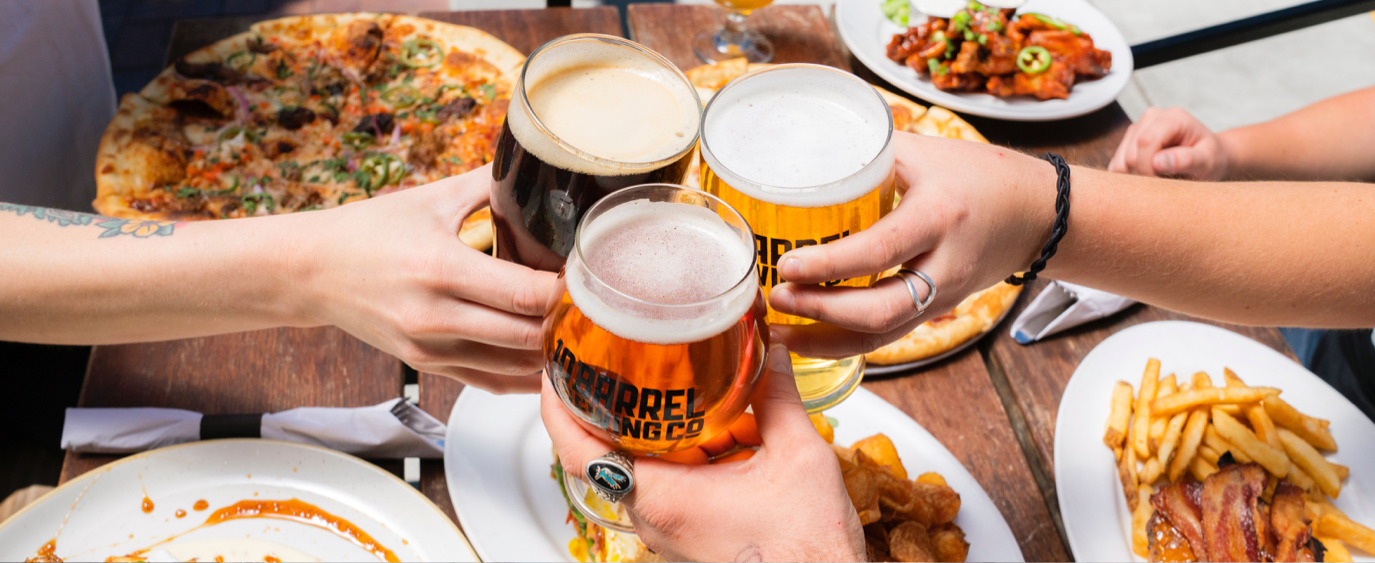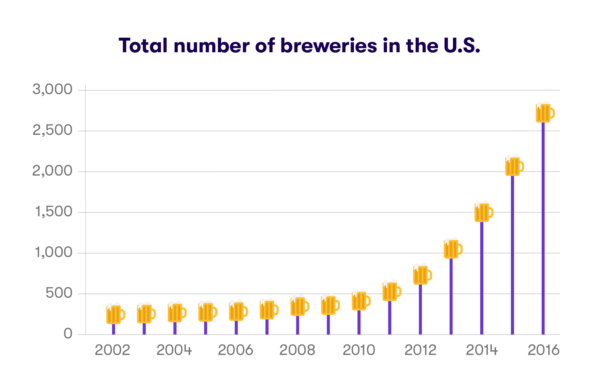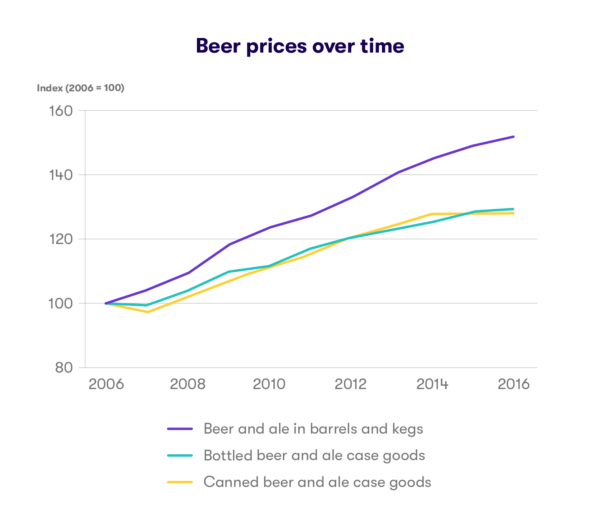Aug 27, 2018
Cheers! All About The Beer Industry
The beer industry is thousands of years old–and it’s a big part of our way of life.

“He was a wise man who invented beer.”
That may sound like something uttered by your buddy at the local watering hole, but these words are actually attributed to the ancient Greek philosopher Plato (whether he actually said them is still up for debate).
Plato, as he was with many other subjects, was onto something: People like beer.
People like beer so much, in fact, that in 2016, we collectively chugged down 186.89 million kiloliters (roughly 49.4 billion gallons), according to analysts. And in the U.S., where we have a wide selection of alcoholic beverages, beer is still the reigning champion. U.S. consumers who drink alcohol regularly favor beer over both wine and liquor by a solid margin.
To satisfy America’s thirst, roughly 60,000 people work in breweries across the country, producing billions of gallons of beer every year.

Source: BLS
Though the industry is being pulled in two different directions–small beer producers (often called “craft” brewers) have exploded in popularity, while the industry overall consolidates into the hands of a few, big corporate players–consumers are reaping the benefits in the form of large, and growing, choices.
And they are even willing to pay more–beer prices climbed more than 50% between 2006 and 2016. The increases are partly due to increased demand for, and subsequent shortages of, hops and barley.

Source: BLS
Tapping the keg: How beer got here
People’s consumption of beer and other alcohol even predated the invention of writing. Archaeologists have found evidence of booze-making in China dating back 9,000 years ago. In parts of Eastern Europe and the Middle East, people began making wine 7,400 years ago.
While the science of fermenting and brewing evolved around the world over thousands of years, commercial brewing reached the U.S. in the 1600s. By the mid-1800s, there were as many as 140 breweries in operation in the U.S., and the industry continued to grow until the Prohibition era.
With the ratification of the Eighteenth Amendment, a constitutional ban on the production and sale of alcohol that lasted from 1920 to 1933, thousands of commercial and independent breweries in operation around the country went underground or shut down completely.
After Congress repealed Prohibition, the industry again kick-started, and brewers were once more able to operate at full-steam. Fast forward to today, and the U.S. is home to roughly 6,400 beer producers making hundreds, if not thousands of different ales, stouts, lagers, and more.
The modern U.S. beer industry
The confounding thing about the modern U.S. beer industry is that it’s simultaneously a vast, competitive space and increasingly monopolistic. In 2000, there were 22 major beer companies in the U.S., but thanks to consolidation, by 2012 there was just a handful.
Here are the biggest U.S. beer producers (by production) as of 2018, according to industry data:
- Anheuser-Busch InBev (Budweiser, Stella, Michelob)
- MillerCoors (Miller, Coors, Molson, Blue Moon)
- Constellation Brands (Corona Extra, Modelo)
- Heineken (Amstel, Red Stripe, Tecate)
- Pabst Brewing (PBR, Schlitz, Rainier, Colt 45)
But nipping at the big boys’ heels are a handful of small, but growing craft brewers. They include Boston Beer Company, Chico, California-based Sierra Nevada Brewing Co., Fort Collins, Colorado’s New Belgium Brewing Company, and Deschutes Brewery, based in Bend, Oregon.
Total U.S. beer sales were $111.4 billion in 2017, according to industry data. And while overall beer sales and consumption were down 1.2% year-over-year compared to 2016, smaller producers have gained some momentum. Craft beer sales were up 5% in 2017, and make up around 23% of the overall beer market.
Sobering statistics
While craft brewers appear to be leading something of a renaissance in the U.S. beer market, bigger beer companies have experienced less consumer demand.
In the second quarter of 2018, for example, Anheuser-Busch InBev’s U.S. revenues fell 3.1% as its flagship brands, like Budweiser and Bud Light, struggle. AB InBev’s struggles could be pointing to a bigger change in consumer tastes, however.
Americans are drinking less beer overall than in previous decades and there are a number of reasons why. Younger people, overall, are worried about the health effects that can result from beer consumption. Women are drinking more wine and cocktails, and some minority groups are drinking more liquor than beer, according to reports.
The defection could be a simple lull in demand, but add in rising prices, which may be exacerbated by tariffs and taxes, and there are a few reasons to feel bearish about the industry’s future, at least in the short-term.
Beer me!
In the long run, however, it may be difficult to bet against beer. Even in the depths of the Great Recession (2009), Americans kept on drinking–and beer was their preferred choice.
And beer can be innovative, too. Some companies, like Constellation Brands and Heineken, are even partnering with cannabis companies to create new THC and marijuana-infused brews. Consumer tastes may be changing, but brewers are evidently reading the tea leaves.
Like certain consumer staples (toilet paper, laundry detergent, etc.), beer is one of those products that many U.S. consumers typically won’t, or can’t, stop buying.
If the thought of investing in the beverage industry whets your appetite, you can get started using Stash.
Related Articles

15 Largest AI Companies in 2024

The 12 Largest Cannabis Companies in 2024

What Is a Traditional IRA?

Saving vs. Investing: 2 Ways to Reach Your Financial Goals

How To Invest in the S&P 500: A Beginner’s Guide for 2024

Stock Market Holidays 2024





